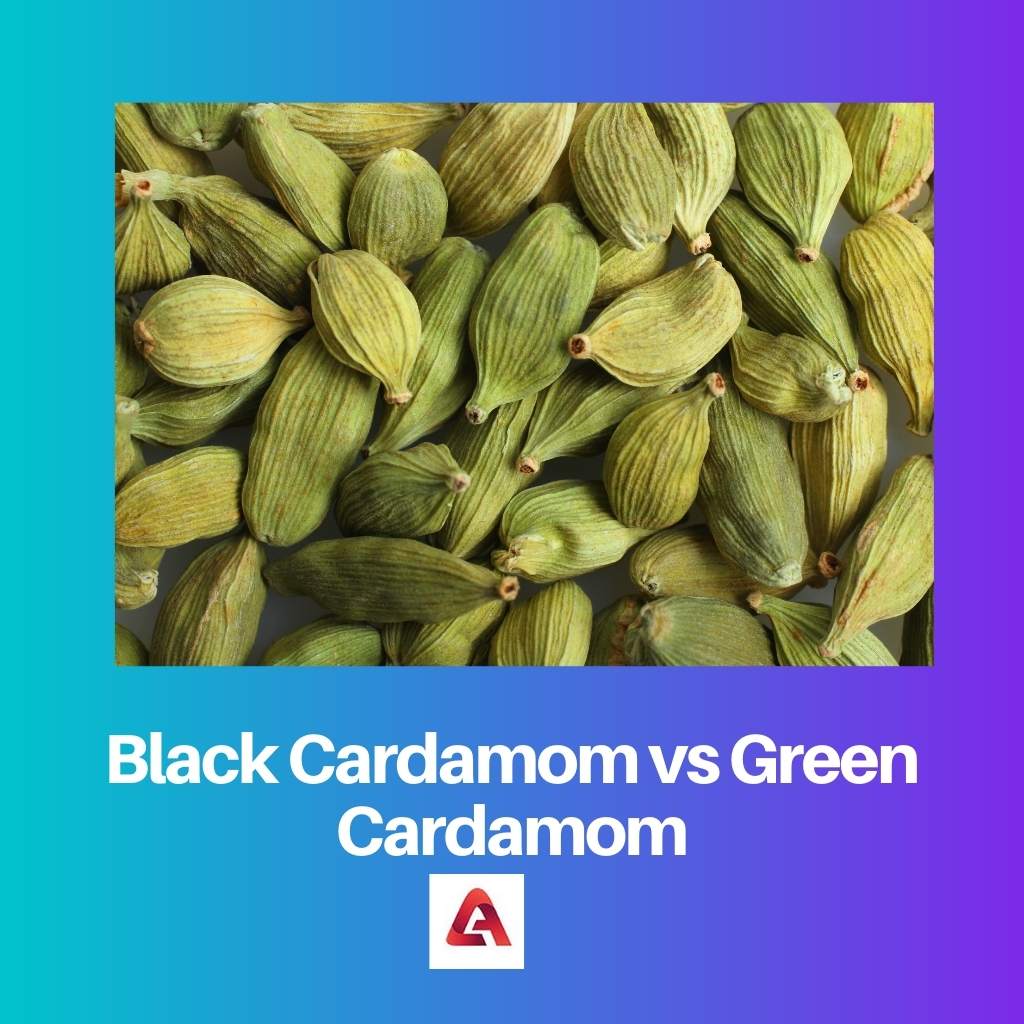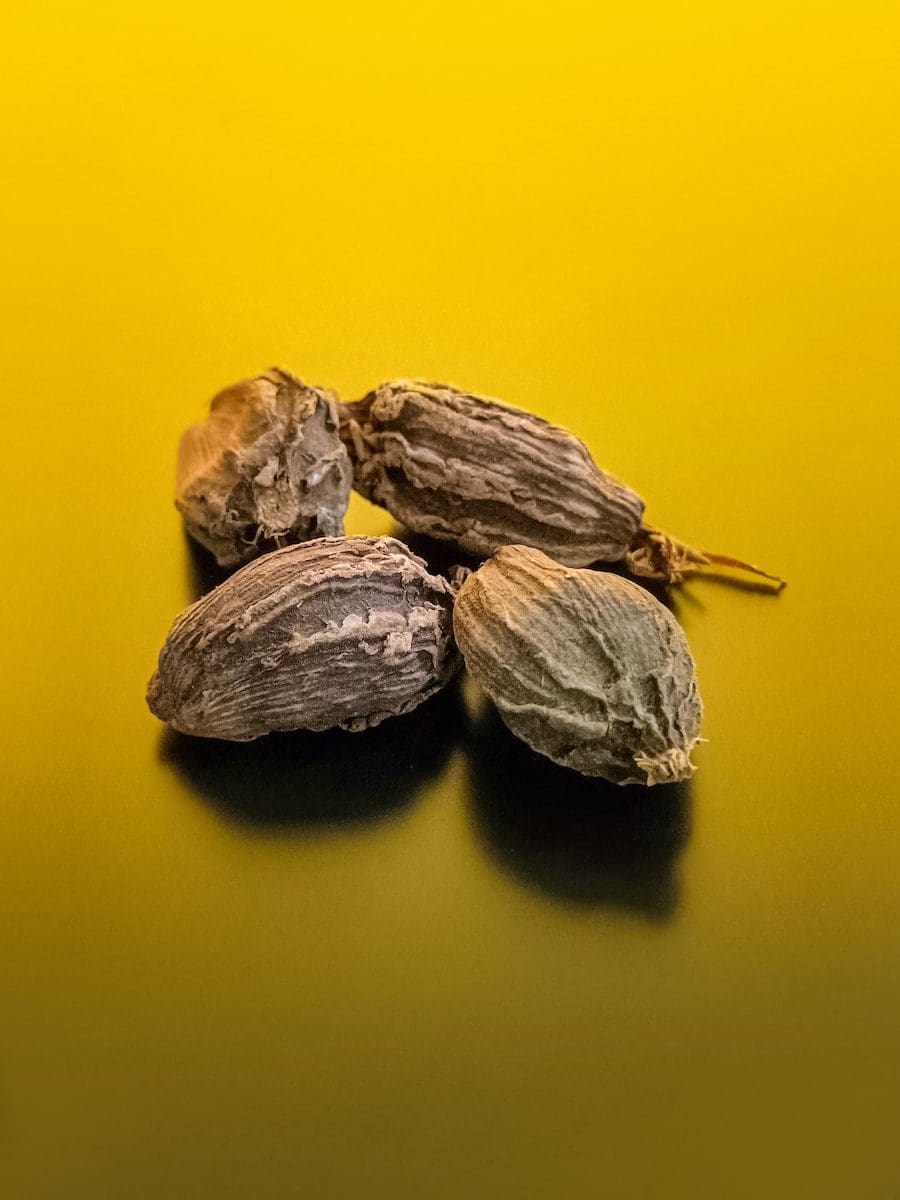Cardamom is the most fundamental thing in any formula utilized in many families. It’s one of the antiquated flavors utilized for cooking, and for the most part, it fills in the western ghats of southern India, Sri Lanka, and Tanzania.
It is additionally ordered based on shading and different attributes. Mainly there are two types of cardamom green cardamom and black cardamom.
Key Takeaways
- Black cardamom has a smoky, earthy flavor, while green cardamom has a sweet, floral flavor.
- Black cardamom is larger and has a dark brown color, while green cardamom is smaller and has a light green color.
- Black cardamom is commonly used in savory dishes like curries and stews, while green cardamom is used in sweet dishes like desserts and tea.
Black Cardamom vs Green Cardamom
Black cardamom, also known as brown cardamom, is native to India and has a smoky, bold flavor with hints of camphor. Green cardamom is native to the Middle East and is known for its sweet, floral flavor with hints of citrus and mint and is used in both sweet and savory dishes such as desserts.

Black cardamom began from the species Amomum subulatum. It is collected long after the plant gets developed. This assortment, for the most part, has a smoky and dubiously camphor-like flavor.
The cost is lower than the green cardamom. It has a few advantages, like treating constipation and looseness of the bowels. It additionally fixes asthma.
Green cardamom began from the species Elettaria cardamomum. It is gathered before the plant gets developed. This assortment, by and large, has an extremely solid and extraordinary smell and flavor.
The cost is extremely higher than the black cardamom. It has a few advantages, like treating rest inconveniences assisting with processing appropriately, and fixing gastric issues.
Comparison Table
| Parameters of Comparison | Black Cardamom | Green Cardamom |
|---|---|---|
| Processing | Black Cardamom is broadly developed in India. Those are by and large reaped long after the plant arrives at its maturity. | Green Cardamoms are developed in India. Those are by and large reaped before the plant arrives at its maturity. |
| Flavor and Usages | Black Cardamom has a smoky and ambiguously camphor-like flavor. Its excellent utilization is to add flavor to food and beverages. | Green Cardamoms have a strong and intense smell and flavor. Its excellent use is adding flavor to food and beverages. |
| Price | The cost of black cardamom is much lesser than the cost of black cardamom. | The cost of green cardamom is a lot higher than the cost of black cardamom. |
| Benefits | It has a few advantages like treating constipation and looseness of the bowels. It additionally fixes asthma. | It has a few advantages like treating rest inconvenience assists with processing appropriately, and fix gastric issues. |
| Size | Black cardamom is bigger than black cardamom in size. | Green cardamom is smaller than black cardamom in size. |
What is Black Cardamom?
Black cardamom is a mainstream Indian flavor, called Badi elaichi or kali elaichi, utilized in many of the food’s particular dishes. It is as seed cases, which are dimly earthy colored to black in shading and take on a smokey flavor because of the manner in which they are dried.
Cardamom is utilized for its strong and decisive taste and is the world’s third-most costly flavor, outperformed in cost per weight exclusively by vanilla and saffron. Both the cases and the seeds are utilized in cooking and accessible all year.
Dark cardamom’s logical name is Amomum subulatum. It fills in cases of a herbaceous plant having a place with the Zingiberaceae (ginger) family. The units have intense, dried, wrinkly skin, are around one inch long, and house little, tacky, dull-shaded seeds.
Dark cardamom has a sharp fragrance with a citrus and eucalyptus flavor.
A few types of the family Amomum are appropriated everywhere in the precipitous region from the Himalayas to Southern China. The fundamental creation areas are Eastern Nepal, India, and Bhutan. In excess of 50% of the world’s collection is created in India.

What is Green Cardamom?
Green cardamom is a zest that is obtained from the ginger group of spices and is known for its zesty sweet taste and solid smell.
The units of the cardamom plant, which are additionally utilized in black cardamom and Madagascar cardamom, should be dried and put away cautiously in light of the fact that they quickly lose their taste and aroma in the wake of being ground.
Green cardamom is marginally more costly than most flavors. Chai tea is made with green cardamom.
Cardamom can be discovered filling in tropical conditions, either in the wild or developed, and available to be purchased. Developing this plant in halfway-cleared tropical jungles is a basic practice, which gives some shade.
Reap happens between the pre-winter and late fall, not long before the plants arrive at development. This keeps the units from parting and drying. It likewise guarantees that they keep up their green tone and top caliber.
Cardamom seed cases, with one opened.
Another name for green cardamom is “grains of heaven.” This zest began in India as right on time as the eighth century. The biggest maker of green cardamom remains India, but since of the enormous homegrown interest in India, just a small amount of it very well may be sent out.

Main Differences Between Black and Green Cardamom
- Black cardamoms are broadly developed in India. Those are, by and large, reaped long after the plant arrives at its maturity, while green cardamoms are developed in India. By and large, those are reaped before the plant arrives at its maturity.
- Black cardamoms have a smoky and ambiguously camphor-like flavor. Its excellent utilization is to add flavor to food and beverages, while Green Cardamoms have a strong and intense smell and flavor. Its excellent use is adding flavor to food and beverages.
- The cost of black cardamom is much lesser than that of black cardamom, while the cost of green cardamom is much higher than that of black cardamom.
- Black cardamom has a few advantages, like treating constipation and looseness of the bowels. It additionally fixes asthma, while green cardamom has a few advantages, like treating rest inconveniences assisting with processing appropriately and fixing gastric issues.
- Black cardamom is bigger than green cardamom in size, while green cardamom is smaller than black cardamom in size.






The article provides a comprehensive and detailed comparison of the flavor, size, price, processing, and benefits of black cardamom and green cardamom, making it a noteworthy resource for spice enthusiasts and culinary aficionados.
Indeed, the detailed exploration of the attributes and uses of black cardamom and green cardamom in various culinary contexts adds significant value to our understanding of these unique spices.
I couldn’t agree more. The article’s comprehensive analysis of the distinct qualities and applications of black cardamom and green cardamom enhances our knowledge of these spices and their diverse uses.
The article offers a compelling comparison of the culinary and medicinal attributes of black cardamom and green cardamom, providing a comprehensive understanding of their unique features and applications.
Absolutely, the article delves into the intricate details of the origins, flavor components, and medical benefits of both black cardamom and green cardamom, adding significant value to the discourse on these spices.
I couldn’t agree more. The comprehensive analysis of black cardamom and green cardamom serves as an educational resource for those interested in delving deeper into the world of spices and culinary applications.
The comprehensive comparison between black cardamom and green cardamom offers valuable insights into their origins, usage, and distinct flavors. This is an excellent resource for food aficionados and culinary enthusiasts.
The article beautifully captures the nuanced flavors of black cardamom and green cardamom. It’s fascinating to learn how these distinct spices are utilized in various culinary applications.
I completely agree. The article presents an informative and engaging analysis of the culinary, botanical, and medicinal aspects of black cardamom and green cardamom. It’s an enriching read.
Indeed, the descriptions of the flavor profiles of both black cardamom and green cardamom are enlightening. It provides a deeper understanding of how these spices can elevate different types of dishes.
The comparison table presented in the article effectively highlights the differences between black cardamom and green cardamom, offering a comprehensive overview of their distinct characteristics and utilizations.
I completely agree. The detailed analysis of the scientific and culinary attributes of black cardamom and green cardamom enhances our understanding of these spices and their versatile applications.
Absolutely, the structured comparison serves as a valuable reference for understanding the diverse applications and beneficial properties of both black cardamom and green cardamom in various culinary contexts.
The article effectively sheds light on the nuanced differences between black cardamom and green cardamom, offering a comprehensive understanding of their scientific properties and culinary applications.
Absolutely, the article provides a detailed account of the unique qualities and applications of both black cardamom and green cardamom, making it a valuable resource for anyone interested in spices and cooking.
The information provided is detailed and comprehensive. It gives a clear understanding of the differences between black cardamom and green cardamom in terms of flavor, usage, and benefits.
I agree, the comparison table is particularly helpful in highlighting the distinctions between black cardamom and green cardamom. It’s a great guide for anyone looking to understand their uses and which one to use in different dishes.
Absolutely, the article provides valuable insights into the scientific and culinary aspects of both black cardamom and green cardamom. This depth of information is truly enriching.
The article provides an in-depth exploration of the unique characteristics, flavors, and uses of black cardamom and green cardamom, making it an enlightening read for those passionate about culinary diversity.
The detailed analysis of the flavor profiles, benefits, and distinct uses of black cardamom and green cardamom is both enlightening and enriching. It deepens the understanding of these versatile spices.
The article offers a thorough exploration of the unique characteristics and benefits of both black cardamom and green cardamom, providing a valuable resource for understanding their diverse culinary and medicinal uses.
Absolutely. The article’s comprehensive coverage of the characteristics and medicinal benefits of black cardamom and green cardamom significantly enriches our understanding of these spices and their diverse applications.
I completely concur. The meticulous examination of the flavor profiles, origins, and beneficial properties of black cardamom and green cardamom serves as an insightful guide for exploring the nuances of these spices.